Choi U-Ram’s “anima-machines” are kinetic sculptures imbued with narrative. From exploring the way human desires are projected onto technological development, he has now turned to questioning the meaning of human existence and symbiosis.
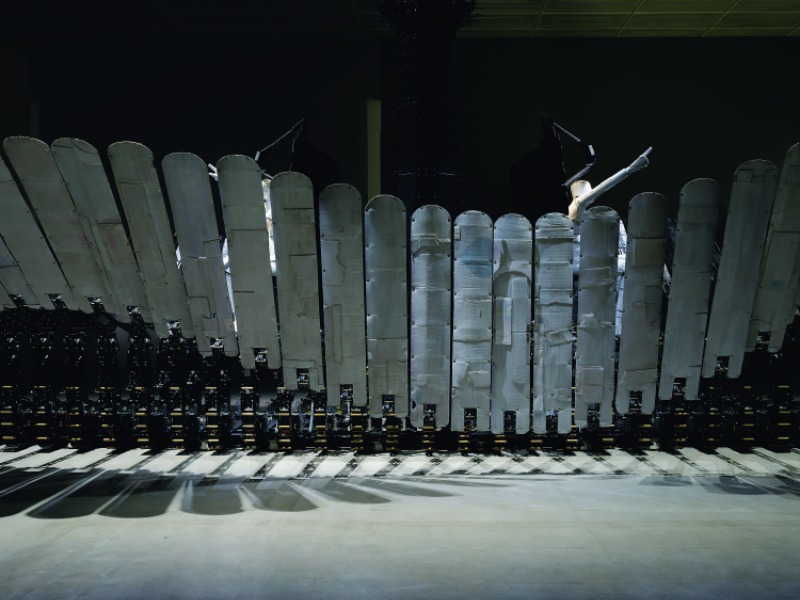
“Little Ark.” 2022. Scrap cardboard boxes, metallic material, machinery, electronic device (CPU board, motor). 210 × 230 × 1272 cm.
When the 35 pairs of oars on each side of the ship start to move, it blends in with the various sculpture installations nearby, giving the impression of a magnificent performance.
Courtesy of the National Museum of Modern and Contemporary Art
“What do people live by?” asked Russian author Leo Tolstoy in the 19th century. A century later, French philosopher Albert Camus reminded everyone that, although we may feel powerless in the face of crisis, solidarity and cooperation may salvage humankind. To such fundamental questions about the meaning of life and the value of humanism, contemporary Korean artist Choe U-Ram gives his answers.
Choe addresses some weighty issues in the exhibition “MMCA Hyundai Motor Series 2022: Choe U-Ram Little Ark,” running through February 26, 2023, at the Seoul branch of the National Museum of Modern and Contemporary Art, Korea. He critiques the inescapable bondage of desire, repetition of unwanted labor, and the age of unlimited competition. Nonetheless, humans dream. We have a will of our own and hold hope in our hearts, which is what makes us human. Hosted by the MMCA and sponsored by Hyundai Motor, the MMCA Hyundai Motor Series has been holding annual exhibitions of acclaimed Korean artists since 2014.
Life Metaphors
Gazing far ahead as you approach the exhibition hall, you will see three black birds slowly circling the ceiling. Looking as if they came from Vincent van Gogh’s “Wheatfield with Crows,” they seem to be after the ball of straw placed on the round black table underneath. This is Choe’s latest work “Black Birds,” which is paired with the installation on the floor called “Round Table.” Headless figures made of straw form a big circle, shoulder to shoulder, carrying the round tabletop. Close up, a mumbling sound can be heard, and the straw figures begin to move. The heavy, round black table, measuring 4.5 meters in diameter, tilts this way and that. A straw clump placed on the table rolls around like a ball. The squatting figures quickly rise when the straw ball rolls their way.
These 18 headless straw figures, unable to think, see, or speak, have lost their sense of direction. They support the round table from underneath and repeatedly stand and squat, just like Sisyphus who repeatedly rolls a boulder up the hill. They are motivated to seize the ball of straw, or the straw head, on the table. When they sense the straw ball coming their way, they quickly get up to claim it, making it roll away in the other direction. If someone were to come out from under the table and get a hold of it, everyone would be spared the hard labor. But no one steps up, and nor do they concede. The birds hovering above mock the scene. They could snatch the straw ball at any moment if they wished to and fly far away.
The detail to watch out for in this artwork are the knees of the straw figures when they try to rise. When they bend or unbend their knees, there is a sense of tension, like a gentle tremor in the muscles, and a sense of urgency. This mere machine surrounded by straw seems to encapsulate the history of human life.
“The anima-machines that I build represent human life and act as metaphors,” Choe said. He dreamed of becoming a robotics engineer when he was a child, but greater imaginings led him on the path of an artist. After majoring in sculpture for both his undergraduate and graduate studies, he began making anima-machines with intricate movements in the 1990s, when he was in his 20s. Later he founded a virtual international lab called United Research of Anima Machine, combining archeology, biology, and robotics. It is a creative collaborative body, comprising experts from different fields, and its acronym, URAM, coincides with his name. For this exhibition, the Robotics Lab of Hyundai Motor Group participated as technical advisor.
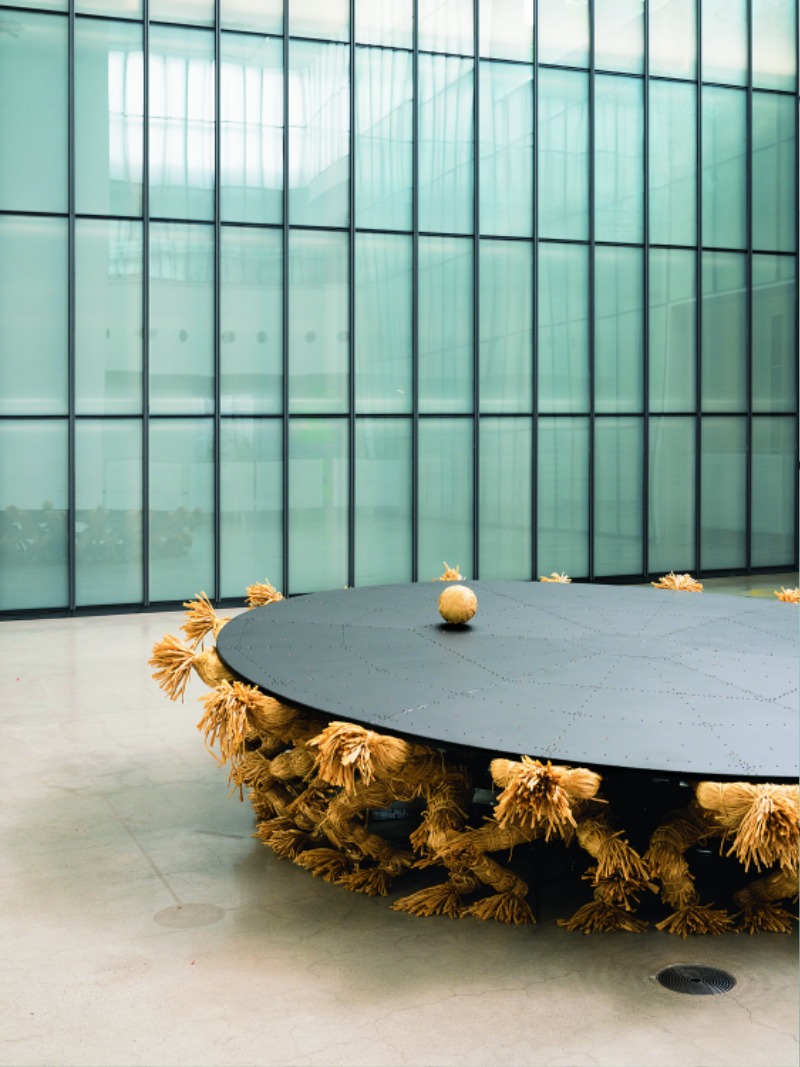
“Round Table.” 2022. Aluminum, artificial straw, machinery, motion detection camera, electronic device. 110 × 450 × 450 cm.
Eighteen human figures made of straw are holding up a round table with a diameter of 4.5 meters. The harder they try to grab the head on top of the table, the farther it rolls away from them. The irony of the situation makes people think about the message.
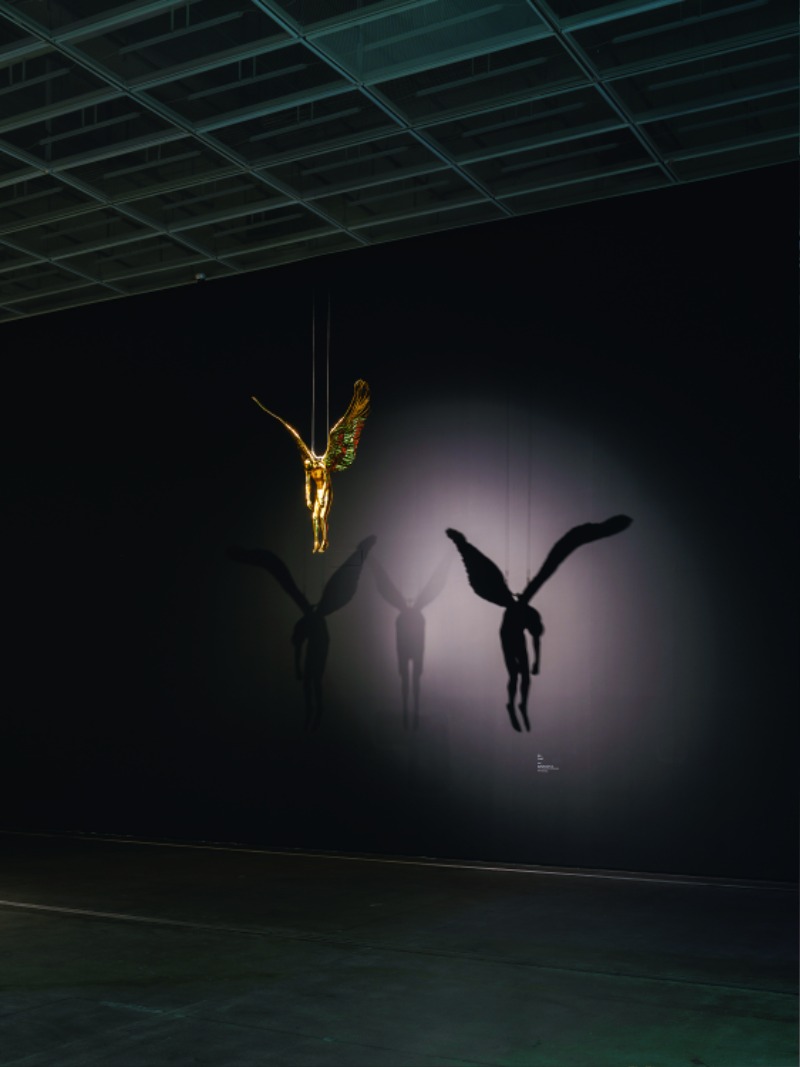
“Angel.” 2022. Resin, 24K gold foil, stainless steel. 162 × 133 × 56 cm.
A golden angel figurehead, which should have been placed on the bow for decoration, is hanging from the ceiling on the left side of the boat, looking frail. It symbolizes modern humans who have lost their sense of direction.
Reality Filled with Absurdities
Of the 53 works in this exhibition, 49 are new. Inside Gallery 5 is “Little Ark,” the exhibition’s titular work. A grand ship 12 meters long, its external appearance is rather daunting, but it can neither float nor move forward without water. When closed up, it resembles a large rectangular chest, 2.1 meters high, clearing adult height. When the oars fold down, the ark extends out to 7.2 meters. On the sides are 35 sets of oars whose movements are as smooth as a dancer’s. Mesmerized, people stand watching it for a long time. Inside the open ship, two captains have their backs turned on each other, pointing in different directions. Whose instructions should we follow? A 5.5 meter-tall lighthouse stands in the middle of the ship. A lighthouse should be fixed on the ground, but if it moves with the ship, it can no longer serve as a constant reference point. The rotating light emanating from the lighthouse is like a surveillance system rather than a guide.
A door opens at the back of the ship. Beyond lies another door, one that is closed. That door opens, too, but to yet another closed door. The title of this video art piece is “Exit.” It depicts a never-ending distant void from which one cannot escape. Positioned on either side of the wall are the anchor and a gilded angel that once decorated the bow. The anchor to hold the ship in place is rolling about in an out-of-reach spot. The angel looks as helpless as Icarus just before his fall, too full of himself and unable to prevent his wings from melting under the sun.
Choe U-Ram planned and built these artworks during the pandemic. “Nothing has changed since I was seven years old, when I drew a robot that would save me from nuclear war. The world is still at war now, and nothing has been solved for good. When we work hard to open the exit door, another more tightly locked door is waiting for us,” he said. “Humans thought they had found the solution with scientific development, but we are still living in a pandemic that is taking people’s lives and creating confusion, just the same as smallpox or the black death. In 2022, it seems we still need an ark. I placed ‘little’ in the title, mindful of endless human desires, never being able to load everything on the ark.”
The title may be “Little Ark” but it is by far Choe’s biggest work. Its message is also in the realm of meta-discourse, touching upon aspects of the creation and destruction of a civilization from the historical perspective and the life-death cycle.
Choe’s works, showing inescapable, absurd situations of lost direction and infinite repetition, speak to the current times. But it is not ridicule. The artist still wants to talk about the hopes and dreams that we hold onto. He has breathed life into things that would otherwise have been thrown out as trash. The “URC” series was created using the headlights and taillights of cars about to be scrapped. The circular sculptures resemble a white planet and a red planet. The lights blink from time to time, showing that they are alive, that hope remains.
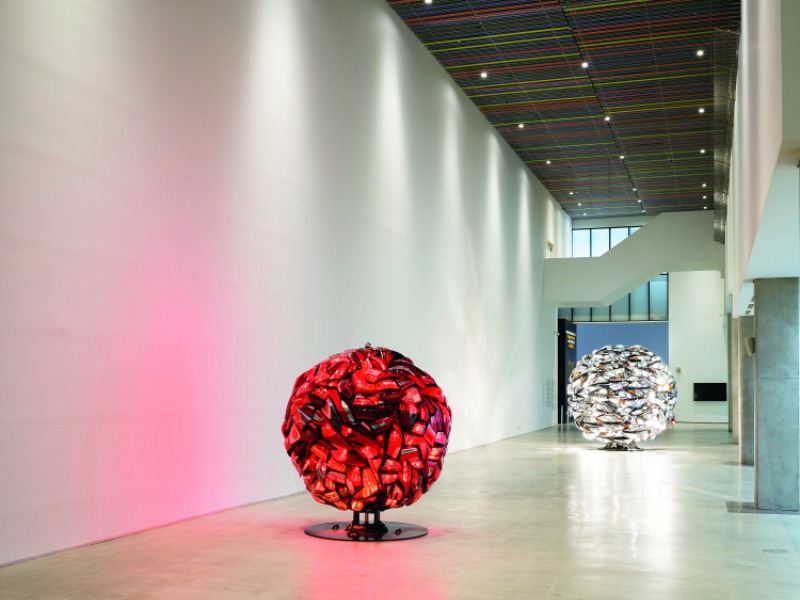
“URC-2.” 2016. Taillights of Hyundai cars, metal, LED, custom CPU board, PC. 170 × 180 × 230 cm. (left)
“URC-1.” 2014. Headlights of Hyundai cars, steel, COB LED, aluminum radiator, DMX controller, PC. 296 × 312 × 332 cm.
The two large spherical sculptures installed in the corridor of Gallery 5 are an assemblage of the headlights and taillights recovered from cars that were about to be scrapped.
Wreaths for the Present Time
The flower installations “One” and “Red” were made from the same fiber (Tyvek) used to make the protective suits worn by medical professionals at COVID-19 testing and treatment sites. Slowly, they go through the repeated motions of blossoming and withering, making a rustling sound. The pace resembles deeply inhaling and exhaling, and it feels nice to breathe deeply with the flowers. Movement means life. In the world’s chaos and confusion induced by a virus, the flowers pay respect and extend gratitude, comfort, and consolation to everyone in a dire life-or-death situation. They are wreaths dedicated to the present time. A flower blooming, withering, and blooming again denotes the circle of life, with humans courageously marching on.
The exhibition has the nature of a retrospective, featuring the designs and technical drawings that Choe made before he began building the machines. We can also see the small and shiny anima-machines on which he has continued to work. They make us look closer because they are small and longer because they are so precise. “Cakra Lamp,” in the shape of a turning wheel, resembles “Round Table,” continually lifted and put down by the straw figures. “Ala Aureus Nativitas,” resembling an insect quickly moving its many legs, with golden wings spread wide, is like a miniature of “Little Ark” with its 35 sets of oars. Size does not matter. The whole cosmos is contained in one small machine. The machines ask us – for what do we live and work so hard?
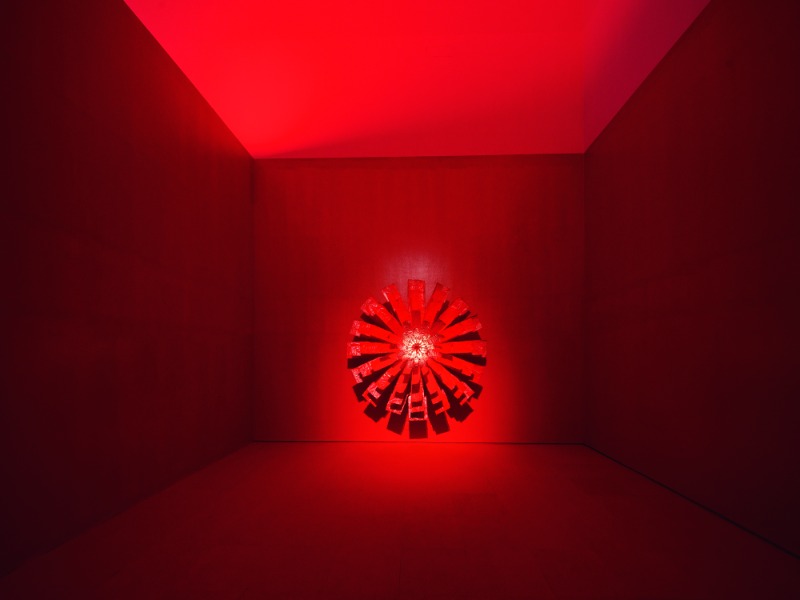
“Red.” 2021. Metallic material, Tyvec and acrylic, motor, electronic device (custom CPU board, LED). 223 × 220 × 110 cm.
The Tyvec fiber used for the petals is the same material used to make the protective suits worn by the medical professionals at the COVID testing and treatment sites. The artist dedicates this flower to all those who are weathering these difficult times.
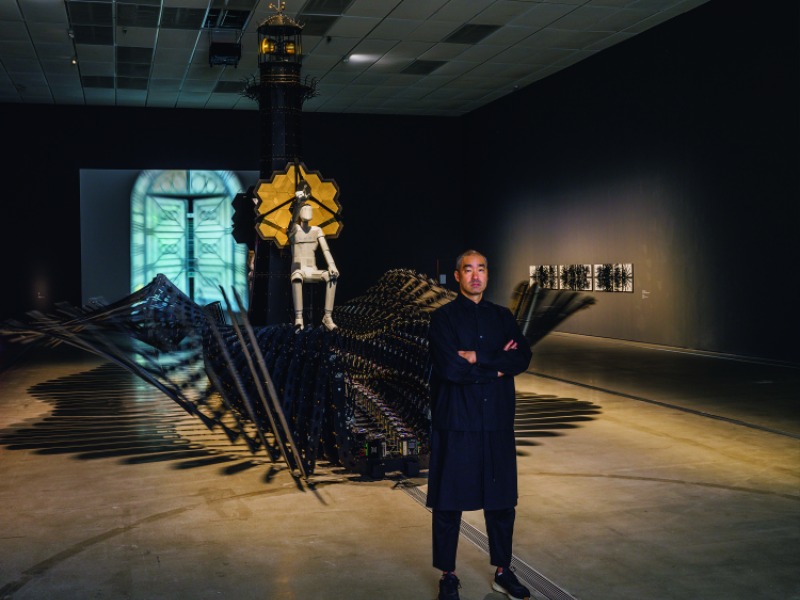
Choe U-Ram is poses in front of “Little Ark.” The artist combines mundane objects with advanced technology to talk about hope in life at his first solo exhibition at the MMCA in Seoul, conveying messages of comfort and consolation in this age of disasters and crises.
Cho Sang-in Journalist, Seoul Economic Daily